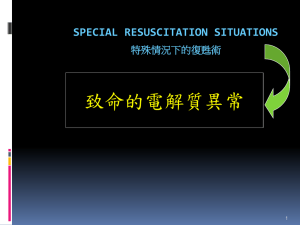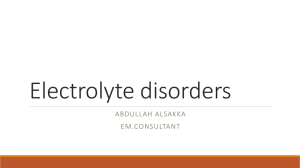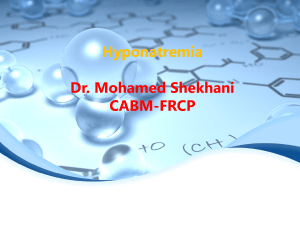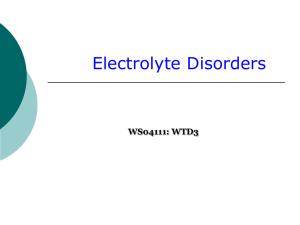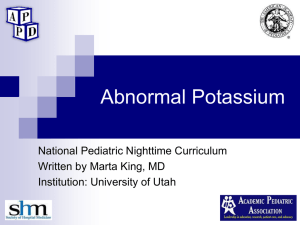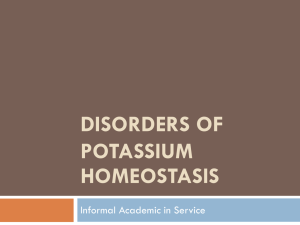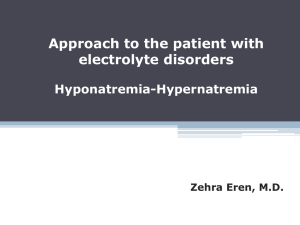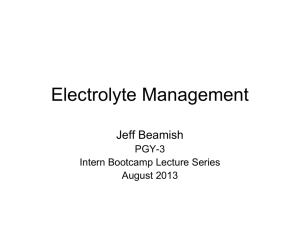Electrolyte Abnormalities or “the H and H`s”
advertisement
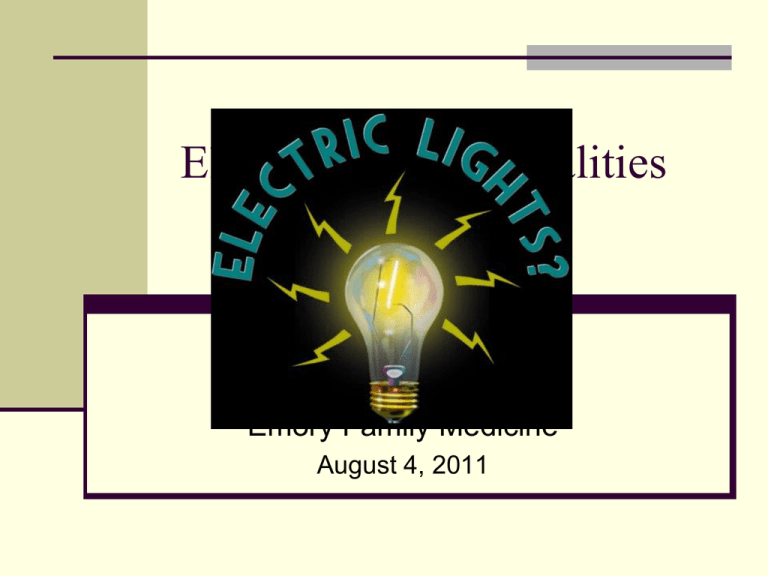
Electrolyte Abnormalities Teresa Lianne Beck, MD Assistant Professor Emory Family Medicine August 4, 2011 Goals Review of common electrolyte abnormalities Normal ranges Clinical manifestations of hypo- or hyperstates Causes Treatment options Goals What will spend time on today… Sodium Potassium Calcium Magnesium Phosphorus Hyponatremia Sodium: Normal 135 – 145 mg / dl Symptoms usually begin <120 mg /dl Nausea Lethargy Muscle cramps Psychosis Seizure Coma Death Hyponatremia Diagnosis based on assessment of serum osmolality and volume status Hyponatremia Serum Osmolality Osmolality (calculated) = 2 (Na) + Gluc / 18 + BUN /2.8 Hyponatremia Normal Osmolality (280 – 295 mOsm / kg) Isotonic pseudohyponatremia Hyperproteinemia (>10 mg / dl) Hyperlipidemia (severe) Hyponatremia High Osmolality (>295 mosm / kg) Hypertonic hyponatremia Hyperglycemia Na: 1.6 mEq / liter decrease per 100 mg/dl increase in glucose Mannitol excess Glycerol therapy Am J Med 1999 Apr;106(4):399-403 Hyponatremia Low serum osmolality (<280 mOsm / kg) Hypotonic hyponatremia Need to assess volume status next in these patients. Hypotonic hyponatremia Hypovolemia GI losses Renal losses plus excess water ingestion Third space losses Tx: Isotonic saline Hypotonic Hyponatremia Hypervolemia CHF Liver disease Nephrotic syndrome CKD Urine Na: < 20 mEq /liter except in CKD Tx: Salt restriction / water restriction / diuretics Hypotonic Hyponatremia Isovolemia Glucocorticoid insufficiency Hypothyroidism Psychogenic polydipsia Medications (amitriptyline / cyclophosphamide / carbamazepine / morphine) SIADH Nausea / pain / emotional stress Diuretic use with potassium depletion Isovolemic Hypotonic Hyponatremia SIADH Syndrome of inappropriate antidiuretic hormone Hypotonic hyponatremia Clinical euvolemia Inappropriately elevated urine osmolality (>200) in face of low serum osmolality Urine Na >20 mEq / liter Normal renal function / TSH / cortisol SIADH Acute tx Severe hyponatremia (<110 mEq / liter) IV lasix NS with 20 – 40 mEq / liter KCL Rarely 3% saline will be needed Chronic tx Mild hyponatremia Water restriction to approx 1000 ml / day Demeclocycline 300 mg PO bid if water restriction not working (contraindicated in liver disease) SIADH Chronic treatment (cont) Vasopressin receptor antagonists Conivaptan (Vaprisol) IV prep 20 mg infusion over 30 min, then gtt of 20 mg/24 hrs Maximum dose 40 mg/24 hrs gtt Maximum duration is 4 days Hyponatremia How fast do we correct it? Hyponatremia Treatment principles Not too fast (pontine myelinolysis) Symptomatic Initial 1 - 2 mEq / L / hr x two hours, then 0.5 mEq / L / hr Asymptomatic 0.5 mEq / L / hr Max in 24 hours: 10 meq total rise Max in 48 hours: 18 meq total rise Am J Med. 2007 Nov;120(11 Suppl 1):S1-21. Hypernatremia Sodium: Normal 135 – 145 mg / dl Clinical manifestations Tremors Irritability Ataxia Spasticity Mental confusion Seizures Coma Death Hypernatremia Cause: Net sodium gain Net water loss Hypernatremia Volume expansion (net sodium gain) Cause Hypertonic saline / NaHCO3 administration Primary hyperaldosteronism Cushing’s syndrome Tx: Diuretics D5W to replace fluid loss after diuretics Hypernatremia Water depletion Hypotonic fluid losses Condition Urine vol Urine osm GI / Insensible loss Low High Renal loss High High Diabetes Insipidus High Low Hypovolemic hypernatremia Treatment Calculate free water deficit TBW (liters) = 0.6 x current total body weight (kg) Desired TBW (liters) = Measured Na (mEq/l) x current TBW / Normal Na Body water deficit (liters) = Desired TBW – current TBW Hypovolemic hypernatremia If hemodynamic compromise, then replace initially with NS Otherwise use ½ NS or D5W Aim to decrease Na by 0.5 mEq / liter / hr Correct one half of the water deficit in 24 hrs Correct other half over next 24-48 hours Hypovolemic hypernatremia Diabetes insipidus Sxs: Polyuria / Polydipsia / Low urine osm Central Tumor / Granuloma / Trauma / Surgery Nephrogenic Severe hypokalemia / hypercalcemia / CKD / Drugs (lithium / demeclocycline / amphotericin) Hypovolemic hypernatremia DI Differentiation of central and nephrogenic Trial of water deprivation Failure to concentrate urine confirms DI Subsequently given arginine vasopressin Central DI (urine concentration increases) Nephrogenic DI (no increase) Hypovolemic hypernatremia DI Treatment Central DDAVPP 5-10 mcg intranasally q day / bid Nephrogenic Correction of underlying cause if possible Genetic abnl / lithium / hypercalcemia Thiazide diuretic / salt restriction can help Hypokalemia Normal K level: 3.5 – 5.0 Clinical manifestations Fatigue Cramps Constipation Weakness / Paralysis Paraesthesias Arrhythmias Hypokalemia EKG abnormalites Flattened T waves ST depressions Prominent U waves http://www.merck.com/media/mmpe/figures/MMPE_12END_156_02_eps.gif Hypokalemia Causes Inadequate intake GI losses Renal losses Acid-base shifts Hypomagnesemia Hyperaldosterone Medications (diuretics) Hypokalemia Treatment Oral therapy Mild hypokalemia Ability to tolerate oral replacement Increase dietary intake Potatoes / Bananas KCl preps (i.e. KDur) Preps can be used in range 8 – 20 mEq Monitor K level and adjust dose as needed Correct cause Hypokalemia Treatment IV repletion Severe hypokalemia Inability to tolerate oral repletion Max Concentration: 60 mEq / liter Note pain is common at > 40 mEq /liter Rate: 10 mEq / hr (20 mEq / hr with tele) Monitor response and decrease conc / rate as appropriate. Hyperkalemia Potassium Normal 3.5 – 5.0 Elevated potassium level should be evaluated as to the following: What is the cause? Is the cause an acute or chronic issue? Are there accompanying EKG changes? Hyperkalemia Symptoms Usually asymptomatic Muscle weakness / paralysis EKG abnormalities Peaked T waves ST depression 1st degree AVB QRS widening “Sine wave sign” Hyperkalemia EKG changes Hyperkalemia Think about the cause 1. Too much total potassium Renal disease Intake increased (rare outside of renal disease) 2. Shift of potassium from intracellular space to extracellular space DKA Hyperkalemia Does the potassium level make sense in the patient? Pseudohyperkalemia (hemolysis) Hyperkalemia When do we treat Patient assessment Cause Chronicity Degree of potassium elevation <6.0 Does not need acute invasive tx >6.0- 6.5 Kayexalate +/- other modalities >6.5 Consider more acute modalities Hyperkalemia Treatment options Calcium gluconate NaHCO3 Regular insulin Albuterol nebulizer treatment Kayexalate Dialysis Hyperkalemia Calcium gluconate IV formulation is 1000 mg / 10 ml (10% soln) Dose: 10 ml over 2-5 minutes IV with EKG monitoring Action: Stabilization of cardiac cells. Does not lower potassium. Used for hyperkalemia with EKG changes. If EKG changes do not immediately resolve, dose can be repeated in 5 minutes. Hyperkalemia Calcium gluconate Precautions Do not infuse with bicarbonate (precipitation of calcium carbonate) Do not use routinely with digitalis as hypercalcemia can augment digitalis toxicity. Limit use to patients with widened QRS. Hyperkalemia Beta agonist Albuterol nebulizer treatment 2-4 ml of 0.5% soln (10-20 mg dose) Note a usual nebulizer tx for RAD is 2.5 mg Peak effect in 90 minutes Epinephrine IV infusion 0.05 mcg / kg / min IV infusion Peak effect in 30 minutes I would be hesitant to use this when an albuterol neb is easy and less risky. Hyperkalemia Insulin Regular insulin 10 units IV plus one D50 Amp over 5 minutes. This will give patient 25 grams of glucose. Follow this with a D 5 containing IV maintenance fluid for several hours. Effect within 15 minutes. Peak effect 60 min. Duration 3-4 hours. Hyperkalemia NaHCO3 1 Amp (44.6 meq) IV over 5 minutes. Onset: 30 minutes Duration: 60-120 minutes Hyperkalemia Alternate approach to NaHCO3 / Insulin: Put 2 Amps NaHCO3 in 1 liter D10 W. Give 300 ml over first 30 minutes, then change to 250 ml / hr until finished. Give Regular insulin 25 units SQ with starting the IVF. Hyperkalemia Kayexalate (Na – K exchange resin) PO dosing: 15 -30 gram Can be used as a dry powder Can be mixed with 60-120 ml of a 20% sorbitol soln to avoid constipation PR dosing: 50 grams Mix with 50 ml of 70% sorbitol and 100 ml tap H20 Retain in rectum x 30 minutes minimum but ideally 2+ hours Hypocalcemia Normal Calcium: 8.9 – 10.3 mg/dl Calcium 40% bound to albumin 15% bound to other serum anions 45% is ionized in serum Hypocalcemia Correct for low albumin 0.8 mg / dl drop in Calcium for every 1 g / dl drop in Albumin Corr Ca = Meas Ca + (0.8 * (4.5 – Meas Alb)) Hypocalcemia Clinical signs of low calcium: Tetany / Carpopedal spasm Trousseau’s sign Chvostek’s sign Lethargy / confusion Seizures Heart failure EKG: Prolonged QT Hypocalcemia Treatment of symptomatic cases Calcium gluconate (10% soln) which contains 100 mg elem calcium / 10 ml. 1. Give two ampules IV over 10 minutes then 2. Add six ampules to 500 ml D5W and infuse at 1 mg / kg / hr Hypocalcemia Asymptomatic Calcium orally Vit D orally (1000 mg / day) Calcitriol 0.25 – 0.5 mcg / day Hypocalcemia Magnesium can be effective as well Magnesium sulfate 2 gram IV bolus followed by 1 gram / hr gtt Hypercalcemia Calcium range: 8.9 – 10.3 mg / dl Symptoms Anorexia N/V Constipation Polyuria Nephrolithiasis Weakness Confusion Coma EKG: Shortened QT interval Hypercalcemia Causes Primary hyperparathyroidism Malignancy Sarcoidosis Vitamin D toxicity Hyperthyroidism Thiazide diuretics Milk-alkali syndrome Renal failure Familial hypocalciuric hypercalcemia Immobilization Hypercalcemia Hypercalcemia Treatment Increase urinary excretion Diminish bone resorption Diminish GI absorption Chelation of ionized Ca (EDTA) Dialysis Hypercalcemia Treatment Increase urinary excretion NS @ 200 – 300 ml / hr to achieve UO = 100 ml /hr Lasix (if fluid overloaded state exists) Hypercalcemia Treatment Decrease bone resorption Calcitonin 4 units SQ or IM q 12 hours This approach works rapidly (4 hrs) and lowers Ca by 1-2 mg / dl Tachyphylaxsis develops after 48 hours Note that nasal dosing does not lower calcium Hypercalcemia Treatment (Decrease bone resorption) Bisphosphonates Zoledronic Acid Hyperglycemia of malignancy Dose: 4 mg IV over 15 minutes Onset 2-4 days (use saline or calcitonin initially) Effect is longlasting (several weeks) 88% pts normalized calcium Can be repeated q 1-4 weeks as needed Pamidronate Alternative Dose: 60-90 mg IV over 2 hours Hypercalcemia Treatment Decreased oral absorption (Need in sarcoid) Oral phosphate administration Prednisone Hypercalcemia Treatment Sensipar (cinacalcet) Calcimimetic indicated for secondary hyperparathyroidism in ESRD Parathyroid carcinoma Dialysis Consider in severe cases Ca 18-20 mg / dl Hypomagnesemia Normal: Magnesium 1.7 – 2.4 mg / dl Symptoms Neuromuscular irritability CNS hyperexcitability Cardiac arrhythmias Hypomagnesemia Think about hypomagnesemia in the following situations: Alcoholism Hypokalemia Hypocalcemia Chronic diarrhea Ventricular arrhythmias Hypomagnesemia Differentiate urinary from GI losses FeMg = (UrMg * PCr) *100 (0.7*PMg*UCr) <2% = GI loss >2% = Renal loss Hypomagnesemia Treatment Severe (<1.0) IV Magnesium sulfate 2 grams IV over 1 hr Mild – moderate PO Magnesium Magnesium chloride (Slo-Mag) 2 tabs PO q day Magnesium oxide (Mag-Ox 400) 2 tabs PO q day Hypermagnesemia Magnesium: Normal range 1.7-2.4 Seen in renal failure with concomitant tx with magnesium containing antacids / laxatives Seen in preeclampsia treated with Magnesium sulfate Notable if Mg >4.0 Hypermagnesemia Treatment Stop the exogenous magnesium HD may be needed in the setting of renal failure Calcium gluconate (10%) 1-2 ampules IV can be given as a bridge to setting up dialysis Hypophosphatemia Phosphorus: Normal 2.6-4.5 mg / dl Symptoms Weakness Respiratory insufficiency or myocardial depression Neurologic symptoms may vary, ranging from simple paresthesias to profound alterations in mental status Hypophosphatemia Causes Hyperglycemic states Alcoholism Respiratory alkalosis GI abns Alum / Mg containing antacids Hyperparathyroidism Renal wasting Hypophosphatemia Treatment Treat underlying cause Replete if severely low Below 1 mg / dl in DKA IV KPhos PO Neutraphos Hyperphosphatemia Phosphorus: Normal 2.6 – 4.5 mg /dl Symptoms (due to hypocalcemia): CNS hyperexcitability, CV Causes: Renal failure Hypoparathyroidism Rhabdomyolysis Tumor lysis syndrome Acidotic states Exogenous admin of phosphorus Hyperphosphatemia Treatment: Dietary restriction 0.6 – 0.9 grams / day Oral phosphate binders Calcium acetate 2 tabs PO q AC Sevelamer (Renegal) 800 mg PO q AC May need to add aluminum containing product (aluminum hydroxide) Dialysis


